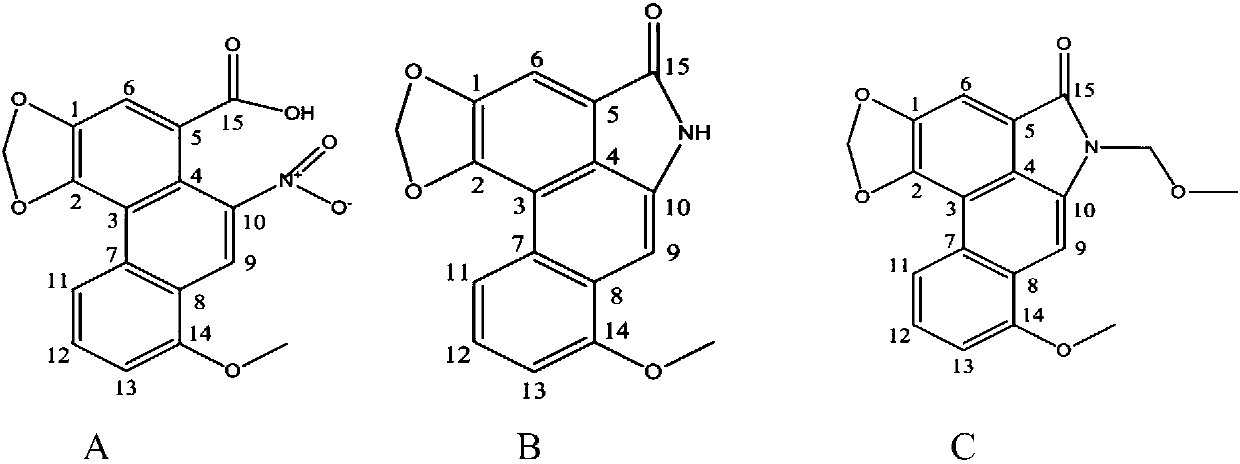Potential and environment-friendly method for separating and screening aristolochic acid and derivative compounds thereof capable of effectively preventing and controlling meloidogyne incognita chitwood
A technology of root knot nematode and aristolochic acid, applied in the directions of botanical equipment and methods, chemicals for biological control, nematicides, etc., to achieve the effects of convenient purchase, wide distribution, and simple and easy technological process
- Summary
- Abstract
- Description
- Claims
- Application Information
AI Technical Summary
Problems solved by technology
Method used
Image
Examples
Embodiment 1
[0031] A potential green and effective separation and screening method for aristolochic acid and its derivatives compounds for preventing and controlling root-knot nematode incognita, comprising the following steps:
[0032] S1: Cut 10 kg of Aristolochia branches into small pieces, dry at 50°C for 10 hours, add 4L of methanol for extraction at room temperature, repeat 3 times, filter with suction, and evaporate the obtained filtrate at 40°C under reduced pressure to obtain methanol extract;
[0033] S2: Dissolve the methanol extract in 1L distilled water, add 1L petroleum ether for extraction, repeat 3 times; continue to extract the aqueous solution layer with 1L chloroform, repeat 3 times; evaporate under reduced pressure to obtain petroleum ether extract and chloroform extract ;
[0034]S3: Petroleum ether extract was mixed with 80-mesh coarse silica gel and separated on a 200-mesh fine silica gel column. Gradient elution, and finally the column was washed with methanol; si...
Embodiment 2
[0042] A potential green and effective separation and screening method for aristolochic acid and its derivatives compounds for preventing and controlling root-knot nematode incognita, comprising the following steps:
[0043] S1: Take 30kg of Aristolochia branches and cut them into small pieces, dry at 60°C for 8 hours, add 4L of methanol to extract at room temperature, repeat 5 times, filter with suction, and evaporate the obtained filtrate under reduced pressure at 55°C to obtain methanol extract;
[0044] S2: Dissolve the methanol extract in 3L distilled water, add 3L petroleum ether for extraction, repeat 5 times; continue to extract the aqueous solution layer with 3L chloroform, repeat 5 times; evaporate under reduced pressure to obtain petroleum ether extract and chloroform extract ;
[0045] S3: Petroleum ether extract was mixed with 60-mesh coarse silica gel and separated on a 300-mesh fine silica gel column. Gradient elution, and finally the column was washed with met...
experiment example 1
[0075] The compound with nematode-killing effect that is separated and screened in Examples and Comparative Examples is subjected to NMR analysis to obtain its structure:
[0076] A. in embodiment 1 and embodiment 2, all obtain three kinds of compounds with killing nematode effect, and structure is as follows:
[0077]
[0078] b. Comparative Example 1 only obtained the above-mentioned compound A which has the effect of killing nematodes, and Comparative Example 2 only obtained the above-mentioned compound B which has the effect of killing nematodes.
PUM
 Login to View More
Login to View More Abstract
Description
Claims
Application Information
 Login to View More
Login to View More - R&D
- Intellectual Property
- Life Sciences
- Materials
- Tech Scout
- Unparalleled Data Quality
- Higher Quality Content
- 60% Fewer Hallucinations
Browse by: Latest US Patents, China's latest patents, Technical Efficacy Thesaurus, Application Domain, Technology Topic, Popular Technical Reports.
© 2025 PatSnap. All rights reserved.Legal|Privacy policy|Modern Slavery Act Transparency Statement|Sitemap|About US| Contact US: help@patsnap.com



